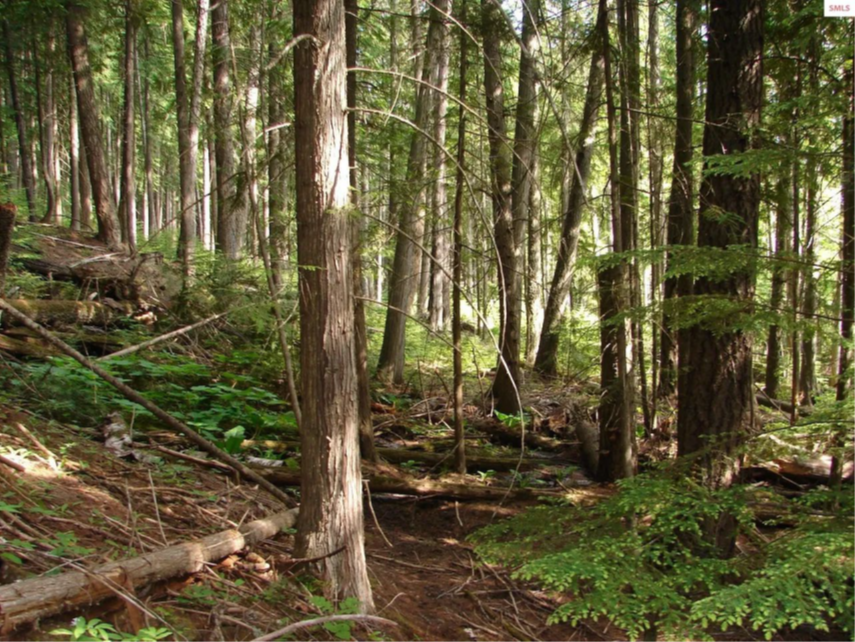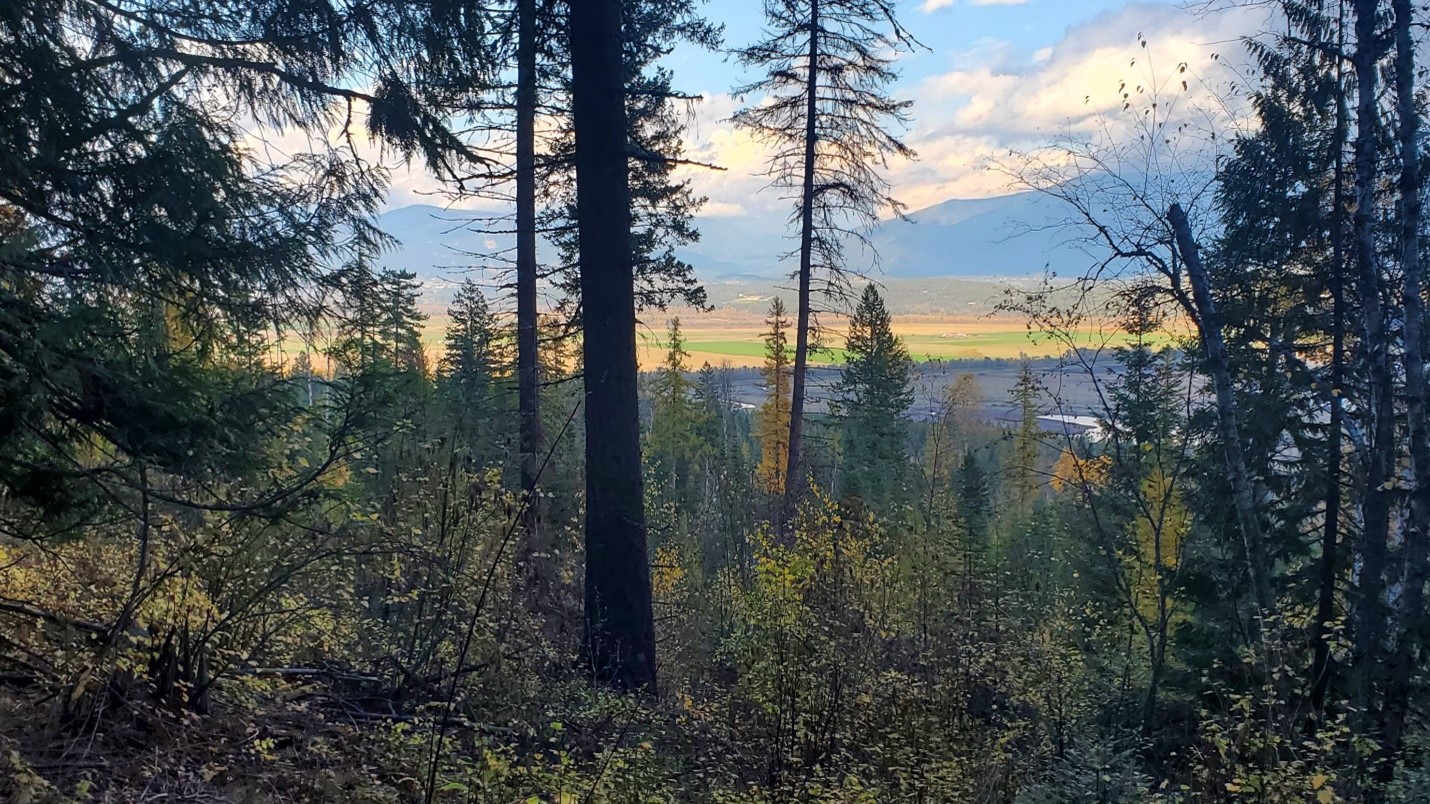Land purchase maintains open wildlife corridor and habitat for grizzly bears and other wildlife
With deep cedar groves, serene landscapes and a seasonal creek, 100-Acre Wood in north Idaho is a special place, and not just because of its natural beauty. This property is also a rich seasonal habitat for grizzly bears with high connectivity value due to nearby mountain ranges and core habitat.
We’re pleased to announce this ecologically important land was secured in December 2023 thanks to a purchase by Y2Y and Vital Ground. Grizzly bears and numerous other wildlife species will benefit with the purchase of 0.4km2 (98 acres) in northern Idaho, just south of the Canadian border.
This is especially important in this place and at this moment in time.
While grizzly bear recovery in the Lower 48 states often focuses on the bears in and around Glacier and Yellowstone national parks, Montana’s northwestern corner and Idaho’s Panhandle also play a major role in the conservation prospects of the two smallest groups of grizzlies persisting south of Canada.
Splitting the Purcell, Cabinet and Selkirk ranges, the Kootenai River flows west through the northwestern corner of Montana then turns north in the Idaho Panhandle, carving a wide valley on its way into Canada. Wildlife moves through this valley between the Selkirk Mountains to the west and the Purcell Mountains to the east.
100-Acre Wood is here, near state and national forestlands and the Boundary-Smith Creek Wildlife Management Area, further solidifying an open movement corridor across the valley for wildlife.
The property may be small in size, but it’s in a critical place.
Securing ecologically significant lands
This habitat protection was possible thanks to support from our partners at Vital Ground and Atira Conservation.
“Working with Vital Ground and willing landowners to conserve lands like this 98-acre property is both strategic and critical,” says Y2Y’s senior connectivity specialist, Eric Greenwell.
“This particular property’s value to wildlife is two-fold: Not only does it sit between the Purcells, Cabinets and Selkirks in the larger landscape, it connects National Forest to incredible habitat in the Boundary-Smith Creek Wildlife Management Area and along the Kootenai River. This is a place Y2Y has made significant restoration and climate adaptation investments through our Bees to Bears project, compounding benefits to wildlife and building on to the remarkable work of great partners.”
In 2006 Y2Y established the Cabinet-Purcell collaborative, a diverse group of more than 60 conservation and community groups, government agencies, scientists and individuals with a goal to recover grizzly bear populations in the vital transboundary Cabinet-Purcell mountain corridor.
The Cabinet-Purcell route is one of only two remaining connections grizzly bears in Canada have with endangered populations in Montana and Idaho. Many wildlife species persist in the small, isolated pockets of protected land here. But roads, small communities and a long history of industrial development threaten their ability to move and stay connected.
100-Acre Wood adds to our long commitment to reconnecting grizzly bears to ensure they thrive into the future.

Improving grizzly recovery — one link at a time
Researchers estimate that after 10 years of collective action, bear numbers have increased in the endangered Cabinet-Yaak grizzly population by more than 160 per cent, up to 50 bears. Increasingly, northern grizzly populations have been seen making their way south. It’s clear these collective conservation efforts are making a difference to our ultimate goal.
But with only a handful of documented cases of gene flow between these populations, maintaining habitat connectivity is crucial to avoiding a future of genetic isolation and eventual extinction for these grizzlies. And with development pressure high across the region, protecting private lands in key corridors is an essential prong in allowing the populations to slowly grow, connect and diversify.
“There’s constant pressure to divide and develop land,” says Greg Johnson, a retired biologist for Idaho Fish and Game who worked on grizzly recovery in northern Idaho for multiple decades. “Where Vital Ground has their most important role is to take on the smaller projects in those really key critical areas. The lower elevations are bottlenecks for key species like grizzly bear. The number one threat is the permanent loss of those habitats.”
Wide-reaching benefits for people and nature
Previously, Owens Foundation for Wildlife owned 100-Acre Wood. Now, the property will be forever protected from subdivision and stewarded to maximize its habitat value. This will not only benefit people but the region’s rich diversity of wildlife, including bears, migratory birds, lynx and even wolverine.
Nearby, Y2Y has also been part of transforming and restoring habitat to help climate sensitive wildlife adapt and thrive into the future in a project called Bees to Bears. To date, some 1 km2 (250 acres) of the meadows of the Boundary-Smith Creek Wildlife Management Area are being restored to address local effects of climate change and help six specific species, plus many other birds and game animals, adapt to these changes.
Habitat protections such as the 100-Acre Wood property and climate adaptation projects like Bees to Bears show how local, on-the-ground, collaborative work can result in a much larger, and positive impact for nature.
All of these projects add up to create a more connected landscape for the Selkirk and Cabinet-Yaak’s recovering grizzly bears. In the face of development pressures, it also maintains the rural and scenic nature of one of the wildest portions of the U.S. West that doesn’t include a national park or large protected wilderness area.
“North Idaho, just like a lot of the West, is facing a surge in population growth and subsequent development pressure,” says Mitch Doherty, conservation director for Vital Ground.
“This particular area near the Canadian border is remote, rugged and some of the most spectacular country in the Northern Rockies. This project will retain that ruggedness and beauty that the longtime residents cherish and wildlife needs.”
This post is based on one originally written by Vital Ground staff.


